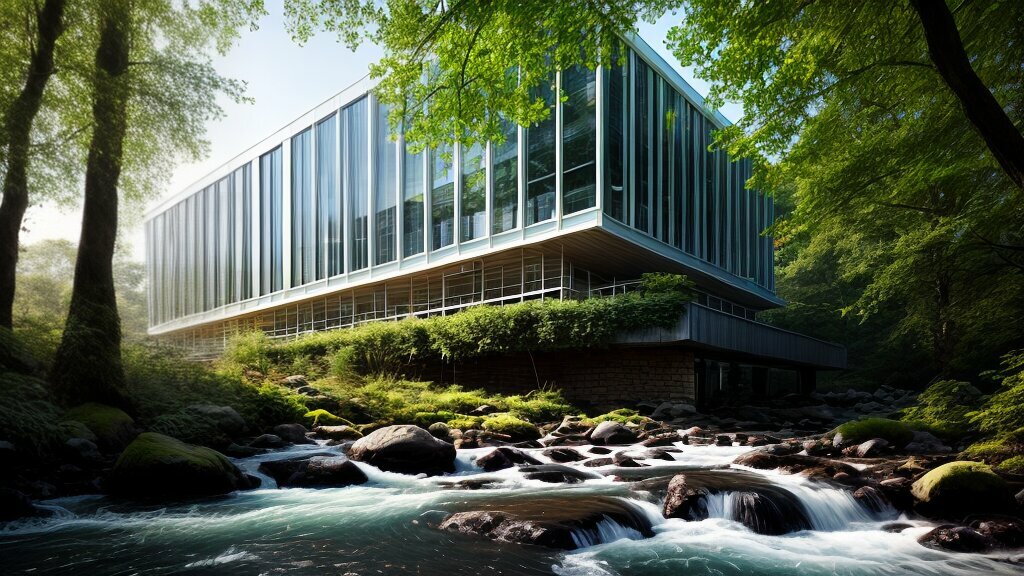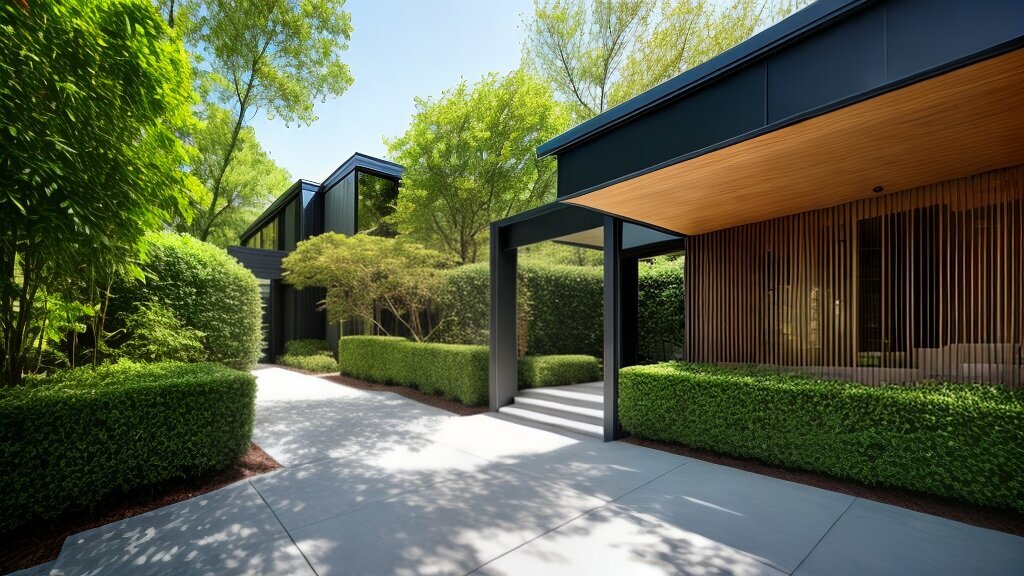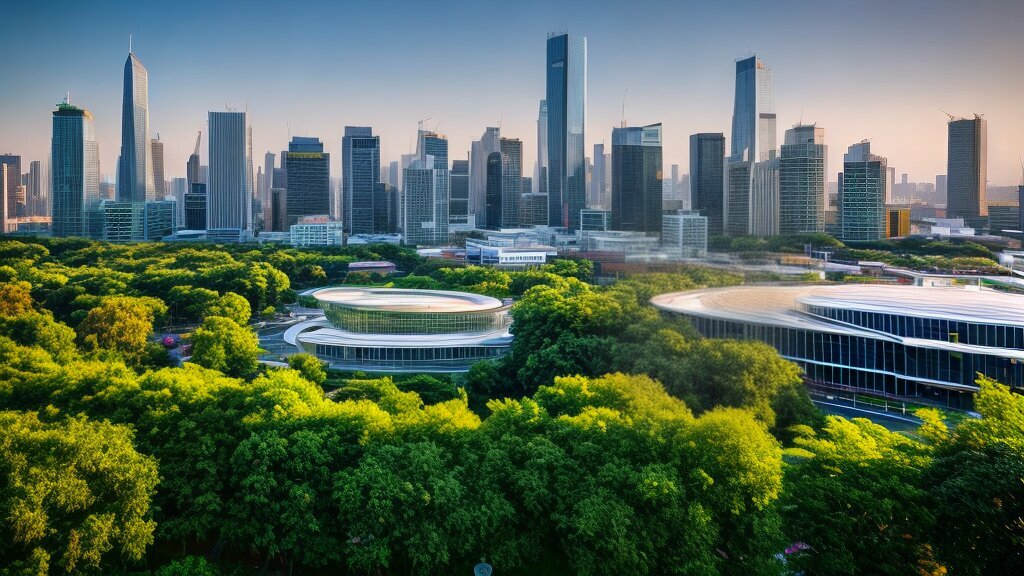Welcome to our exploration of cutting-edge green building certifications! As sustainability becomes increasingly important in the construction industry, innovative and comprehensive approaches to green building practices have emerged. These certifications go beyond the traditional LEED certification, providing a more holistic and forward-thinking approach to sustainable construction.
Through this article, we will explore the evolution of green building certifications, the advantages of pursuing cutting-edge green building certifications, notable certifications available today, the criteria and process involved in obtaining these certifications, and case studies of innovative green buildings that have achieved them. We will also discuss the growing market demand for cutting-edge green building certifications, challenges faced by developers, architects, and contractors, and the long-term benefits of these certifications beyond the initial recognition.
Key Takeaways:
- Cutting-edge green building certifications are innovative and comprehensive approaches to sustainability in construction.
- These certifications go beyond the traditional LEED certification and provide a more holistic and forward-thinking approach to sustainable construction.
- Throughout this article, we will explore the evolution of green building certifications, the advantages of pursuing cutting-edge green building certifications, notable certifications available today, the criteria and process involved in obtaining these certifications, and case studies of innovative green buildings that have achieved them.
The Evolution of Green Building Certifications
Green building certifications have come a long way since their inception. Initially, certifications primarily focused on energy efficiency and reducing carbon emissions. However, as the importance of sustainable design and environmentally-responsible building practices gained recognition, the certifications began to evolve to encompass a wider range of criteria.
Today, eco-friendly building accolades extend beyond energy efficiency to encompass a broad range of sustainable design principles. Certifications increasingly prioritize environmentally-responsible building practices, including water conservation, indoor air quality, and material selection.

Notable certifications that have emerged to address specific aspects of environmental responsibility in building construction include the Living Building Challenge, which is a performance-based accreditation that evaluates buildings on their impact on the environment, equity, and human health. The WELL Building Standard focuses on promoting occupant well-being by addressing factors such as access to healthy food, lighting, and physical activity. The Forest Stewardship Council certification recognizes materials that come from sustainably managed forests.
The LEED Certification
The Leadership in Energy and Environmental Design (LEED) certification is the most widely recognized green building certification. Developed by the U.S. Green Building Council (USGBC), LEED certification evaluates a building’s overall environmental impact based on factors such as energy performance, water efficiency, indoor air quality, and site sustainability. LEED also offers a framework for sustainable design and construction practices.
Despite its prominence, the LEED certification has received criticism for not going far enough in promoting advanced sustainable design principles. As such, emerging cutting-edge green building certifications offer more innovative and comprehensive approaches to green building practices.
“Green building certifications are no longer just focused on energy efficiency, but also on occupant well-being, water conservation, and the use of sustainable materials.”
In the next section, we explore the advantages of pursuing cutting-edge green building certifications and how they can contribute to the sustainability and performance of buildings.
Advantages of Cutting-Edge Green Building Certifications
Obtaining cutting-edge green building certifications offers numerous benefits for building developers, occupants, and communities as a whole. These innovative certifications go beyond traditional sustainability measures and require a more comprehensive and holistic approach to construction practices.
One significant advantage of cutting-edge certifications is their potential to significantly improve the performance of buildings and ensure occupant well-being. By incorporating features such as energy-efficient systems, healthy air quality, and sustainable materials, these certifications can create healthier and more comfortable living and working spaces. Additionally, the use of renewable energy sources and reduced reliance on fossil fuels can reduce a building’s carbon footprint and contribute to the overall sustainability goals of communities.
Moreover, cutting-edge green building certifications can act as recognitions of sustainable development practices and serve as valuable marketing tools for building developers. Buildings that achieve these certifications are often viewed as prestigious and attractive to potential tenants, investors, and customers who prioritize environmental responsibility. As such, these certifications can increase the value of a building and generate higher rents and returns on investment.
Image source: https://seowriting.ai/32_6.png
Furthermore, cutting-edge green building certifications can contribute to the overall environmental and social goals of communities. By promoting sustainable construction practices, these certifications can support the creation of resilient and adaptable cities that can withstand the challenges of climate change and resource depletion. Additionally, these certifications can encourage the creation of green jobs and support the development of local economies.
In summary, cutting-edge green building certifications offer numerous advantages for building developers, occupants, and communities. By promoting sustainable construction practices and enhancing building performance, these certifications can contribute to the creation of healthier and more sustainable living and working environments.
LEED and Beyond: Notable Green Building Certifications
While LEED certification remains the most well-known and widely used green building certification globally, many other cutting-edge green building certifications have emerged in recent years. These certifications offer more comprehensive and innovative approaches to sustainable design and construction, addressing specific aspects of environmental responsibility beyond energy efficiency and resource conservation.
One notable certification is the Living Building Challenge (LBC), which goes beyond LEED’s focus on reducing environmental impact to prioritize regenerative design that produces more positive than negative effects on the environment. To achieve LBC certification, a building must demonstrate net-zero energy, water, and waste, as well as incorporate non-toxic, locally sourced materials.
| Certification |
Focus Areas |
Notable Features |
| BREEAM |
Energy, Water, Materials, Health & Wellbeing, Pollution |
Emphasizes occupant health and wellbeing, incorporates life cycle assessments and carbon footprint analysis |
| Green Globes |
Energy, Water, Materials, Emissions, Indoor Air Quality |
Offers a flexible, customized approach to certification with an online assessment tool and on-site evaluations |
| WELL Building Standard |
Indoor Air Quality, Lighting, Water, Nourishment, Fitness, Comfort |
Focuses on enhancing occupant health and wellbeing through design features such as circadian lighting and enhanced ventilation |
Another certification gaining traction is the BREEAM certification, which originates from the UK and has expanded globally. BREEAM emphasizes occupant health and wellbeing, incorporating life cycle assessments and carbon footprint analysis into its evaluation criteria.
Green Globes is another certification that offers a flexible, customized approach to certification with an online assessment tool and on-site evaluations. The certification evaluates buildings on energy efficiency, water conservation, materials selection, emissions reduction, and indoor air quality, among other factors.
The WELL Building Standard, meanwhile, focuses specifically on enhancing occupant health and wellbeing through design features such as circadian lighting, improved water quality, and enhanced ventilation. The certification evaluates buildings in areas such as indoor air quality, lighting, and occupant comfort, emphasizing the importance of a holistic approach to sustainable design.

These cutting-edge green building certifications showcase the diversity of sustainable design and construction approaches and highlight the importance of addressing a broad range of environmental responsibility factors beyond energy efficiency and resource conservation. By pursuing these certifications, building owners and developers can demonstrate their commitment to sustainability and contribute to a greener and more resilient built environment.
Certification Criteria and Process
Obtaining cutting-edge green building certifications involves meeting specific criteria and following a detailed process. These certifications evaluate a range of factors, from energy and water efficiency to indoor air quality and materials selection. Here are some of the key elements that are typically assessed:
| Criteria |
Description |
| Energy Performance |
Buildings must demonstrate high levels of energy efficiency through the use of renewable energy sources, insulation, and other measures. |
| Water Efficiency |
Buildings must conserve water, either through the use of low-flow fixtures and other technologies or through recycling and reusing water. |
| Indoor Air Quality |
Buildings must maintain high levels of indoor air quality through the use of ventilation, filtration systems, and non-toxic building materials. |
| Materials Selection |
Buildings should use environmentally responsible materials, such as recycled, non-toxic, and locally sourced materials, and reduce waste through sustainable construction practices. |
| Site Sustainability |
Buildings must be designed and constructed to minimize their impact on the surrounding site and natural environment through practices such as stormwater management, site remediation, and habitat restoration. |
The specific requirements and documentation needed to achieve cutting-edge green building certifications vary depending on the certification sought. Some certifications require the submission of detailed plans and specifications, while others may involve on-site inspections and performance measurements. However, all certifications share the common goal of promoting sustainable development and environmentally responsible building practices.

Image source: seowriting.ai
Case Studies: Examples of Innovative Green Buildings
Let’s take a closer look at some buildings that have achieved cutting-edge green building certifications, showcasing their sustainable design and construction practices.
The Edge, Amsterdam, Netherlands

The Edge in Amsterdam is one of the world’s most sustainable office buildings, boasting a BREEAM score of 98.36%. The building has a range of innovative features, including a smart lighting system that automatically adjusts to the movements of occupants, solar panels that generate enough energy to power the building, and a rainwater collection system that supplies the building’s greywater needs. The Edge has been praised for its energy efficiency, smart technology integration, and healthy indoor environment.
The Bullitt Center, Seattle, USA

The Bullitt Center in Seattle is considered one of the greenest commercial buildings in the world, earning a Living Building Challenge certification. The building features a range of sustainable systems, such as a rooftop solar panel array, rainwater collection and treatment system, and a composting toilet system. Additionally, the building uses a range of natural materials, such as locally-sourced wood and non-toxic finishes. The Bullitt Center is a prime example of regenerative design and innovative sustainability practices in action.
The Crystal, London, England

The Crystal in London is one of the world’s most sustainable buildings, receiving a BREEAM Outstanding rating and a LEED Platinum certification. The building is powered entirely by renewable energy sources, featuring integrated solar panels, ground source heat pumps, and biomass boilers. The Crystal also has a range of low-carbon transport initiatives, including EV charging points and a car club. Its impressive water management system includes rainwater harvesting and greywater reuse, contributing to a 70% reduction in water consumption compared to similar buildings.
These cutting-edge green buildings serve as models for sustainable and innovative design, providing inspiration for future green building projects around the world.
Market Demand and Future Trends
The demand for cutting-edge green building certifications continues to grow as more individuals, organizations, and governments recognize the importance of sustainable development. According to a report by the World Green Building Council, there is a strong market demand for green buildings, with over 60% of the surveyed companies saying that they are planning to build or retrofit green buildings in the next few years. This trend is expected to continue as the construction industry places a greater emphasis on environmental responsibility and resource efficiency.
In addition to this growing demand, there are also emerging trends in the green building industry that reflect a shift towards more innovative and holistic approaches to sustainability. For instance, there is an increasing focus on renewable energy systems, such as solar panels and wind turbines, to power buildings and reduce reliance on fossil fuels. There is also a greater emphasis on regenerative design, which seeks to create buildings that not only minimize negative environmental impacts, but also contribute positively to the local ecosystem. Finally, there is a growing recognition of the importance of social equity in green building, with a focus on creating buildings that benefit all members of society, regardless of income, race, or background.

As the green building industry continues to evolve, it is important for developers, architects, and contractors to stay up-to-date on the latest trends and certifications in order to remain competitive in the market and meet the demands of clients and investors. By pursuing cutting-edge green building certifications, they can demonstrate their commitment to sustainability, enhance the performance and value of their buildings, and contribute to the overall health and well-being of the planet.
Challenges and Solutions in Achieving Cutting-Edge Green Building Certifications
While cutting-edge green building certifications offer numerous benefits, there are also some challenges that developers, architects, and contractors face in achieving them. One of the biggest hurdles is the perceived cost implications of implementing sustainable practices and technologies. However, studies have shown that the additional costs of going green are often outweighed by the long-term savings in energy and water consumption, improved building performance, and increased tenant satisfaction and retention.
Another challenge is the lack of awareness or knowledge among industry professionals about the available sustainable design strategies, materials, and technologies. This can make it difficult to meet the specific criteria and documentation requirements of cutting-edge green building certifications. To overcome this challenge, education and training programs can be implemented to provide professionals with the necessary skills and knowledge to achieve these certifications.
Technical complexities can also be a challenge, as cutting-edge green building certifications often require the integration of multiple sustainable features and systems. This can be particularly daunting for smaller projects or those with limited budgets. However, partnering with experienced green building consultants and contractors can help overcome these technical challenges and ensure that projects meet the necessary certification criteria.
Ultimately, the benefits of cutting-edge green building certifications far outweigh the challenges, and there are solutions available to overcome them. By addressing these challenges and promoting widespread adoption of sustainable building practices, we can create a more environmentally-responsible and resilient built environment.

Benefits Beyond Certification: Creating Lasting Impact
While cutting-edge green building certifications offer numerous benefits to buildings and their occupants, their impact extends far beyond the initial recognition. This section will explore the long-term benefits of pursuing sustainable development recognitions and how they contribute to creating lasting impact and promoting environmental responsibility in the built environment.
Attracting Investments and Tenants
Buildings that achieve innovative green building accolades often attract more attention from investors and tenants who prioritize sustainability and environmental responsibility. These certifications serve as a testament to a building’s commitment to reducing its carbon footprint and promoting sustainable practices, making them more attractive in the competitive real estate market. Additionally, green buildings often have lower operating costs, making them a more financially sound investment in the long run.
Contributing to the Resilience of Cities and Communities
Green buildings play a crucial role in creating resilient and sustainable communities. By prioritising sustainable construction certifications and implementing innovative green building practices, buildings become more energy-efficient, reduce waste, and lower their carbon footprint. This results in more significant reductions in local greenhouse gas emissions and can contribute to mitigating the impact of climate change. Additionally, green buildings often have better indoor air quality, which promotes the health and well-being of occupants and the community at large.

Fostering a Culture of Innovation and Environmental Responsibility
By pursuing cutting-edge green building certifications, building owners and developers are promoting a culture of innovation and environmental responsibility in the built environment. These certifications encourage the use of new and sustainable construction techniques and materials, which can inspire future development and influence the wider industry to adopt more sustainable practices. This leads to a ripple effect that goes beyond individual buildings, promoting a more sustainable and resilient built environment as a whole.
In conclusion, while achieving cutting-edge green building certifications is an impressive achievement, the true value of these recognitions is in the long-term benefits they offer. By prioritising sustainability and environmental responsibility in the built environment, we can create lasting impacts that benefit not only the occupants of green buildings but also the wider community and the environment as a whole.
Conclusion
In conclusion, cutting-edge green building certifications are essential for promoting sustainable development and environmentally-responsible building practices. As we have explored in this article, these certifications offer innovative and comprehensive approaches that go beyond the traditional LEED certification.
By pursuing cutting-edge green building certifications, developers, architects, and contractors can enhance the sustainability and performance of their buildings, improve occupant well-being, and contribute to the overall environmental goals of communities.
Furthermore, cutting-edge green building certifications have long-term benefits beyond the initial recognition. They contribute to the overall sustainability and resilience of cities and communities, attract investments and tenants, and foster a culture of innovation and environmental responsibility in the built environment.
We encourage everyone to explore and pursue cutting-edge green building certifications to contribute to a greener and more sustainable future. Let us work together to transform the built environment and create a better world for all.
FAQ
Q: What are cutting-edge green building certifications?
A: Cutting-edge green building certifications are sustainable construction certifications that go beyond the traditional LEED certification and offer more innovative and comprehensive approaches to green building practices.
Q: How have green building certifications evolved over time?
A: Green building certifications have evolved from initially focusing on energy efficiency to encompassing a broader range of sustainable design principles. There are now certifications that address specific aspects of environmental responsibility in building construction.
Q: What are the advantages of cutting-edge green building certifications?
A: Cutting-edge green building certifications enhance the sustainability and performance of buildings, improve occupant well-being, and contribute to the overall environmental goals of communities.
Q: What are some notable cutting-edge green building certifications?
A: Some notable cutting-edge green building certifications include [Certification Name 1], [Certification Name 2], and [Certification Name 3]. These certifications have unique features, criteria, and differ from the LEED certification.
Q: What is the criteria and process for obtaining cutting-edge green building certifications?
A: The criteria for cutting-edge green building certifications evaluate aspects such as energy performance, water efficiency, indoor air quality, materials selection, and site sustainability. The process involves meeting specific requirements and providing necessary documentation.
Q: Can you provide case studies of buildings with cutting-edge green building certifications?
A: Yes, here are some examples of buildings that have achieved cutting-edge green building certifications and showcase sustainable design and construction practices.
Q: What is the market demand for cutting-edge green building certifications?
A: The market demand for cutting-edge green building certifications is growing, as more individuals, organizations, and governments prioritize sustainability in construction. There are emerging trends in green building certifications, such as the integration of renewable energy systems and a focus on social equity.
Q: What are the challenges in achieving cutting-edge green building certifications?
A: Developers, architects, and contractors may face challenges such as cost implications, lack of awareness or knowledge, and technical complexities. However, solutions can be explored to overcome these challenges and promote widespread adoption of sustainable building practices.
Q: What are the long-term benefits of cutting-edge green building certifications?
A: Cutting-edge green building certifications contribute to the overall sustainability and resilience of cities and communities, attract investments and tenants, and foster a culture of innovation and environmental responsibility in the built environment.
In this feature, you can discover about Green Building Incentives and Policies.



























Post comments (0)